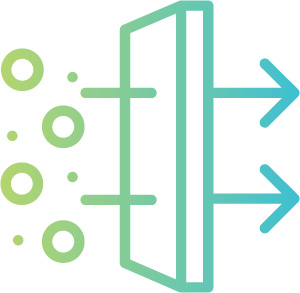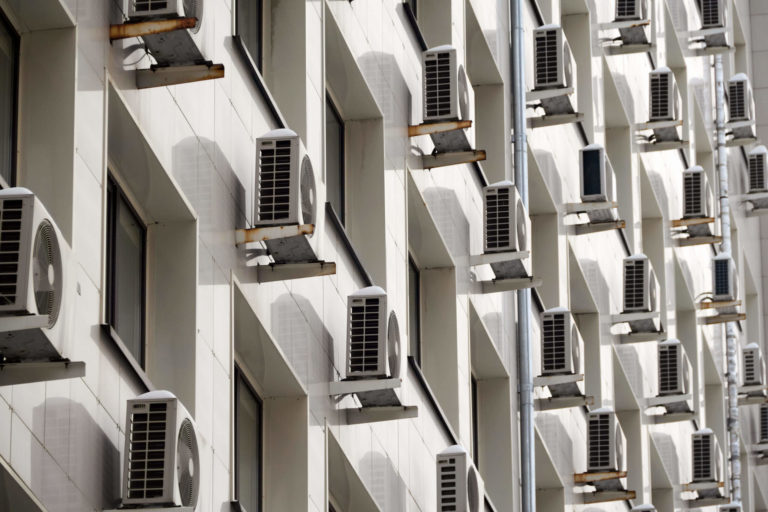Fresh Air
& Customized
Comfort
Tailor temperature
room-by-room by TTAP solution
Heat and cool individual
spaces to maximize comfort and productivity
Augments central air by
providing refreshed air locally, for improved air quality
Designed to operate
with virtually no sound
Cool or heat – room by room – Fresh air promotes healthy environment
Welcome to 100% on-demand heating and cooling with the TTAP platform.
In this uniquely designed HVAC solution, fresh or partially treated air is delivered throughout the building to each TTAP unit – which optimizes the temperature for each space.
Meets air quality requirements
TTAP technology makes it simple to deliver fresh air and enable a healthier, more productive work environment, while also meeting ever increasing air quality requirements such as ASHRAE 24.

Clean air is filtered locally

State of the art customization
Customized comfort
On-demand heating and cooling, delivered room-by-room, provides a level of customized temperature control never before seen in the industry. With a sleek, minimal design, the TTAP unit blends instantly into its surroundings. What’s more, the TTAP unit is virtually silent during operation, delivering comfort to room occupants.
Contact us for more information

How cooling hurts the environment
The most hazardous elements in traditional refrigeration and cooling technology are refrigerants – chemical compounds used as the heat carrier within systems. Throughout the refrigeration cycle, refrigerants change from gas to liquid and back to gas again absorbing and releasing heat; this cycle creates the desired cooling effect.
Heavily regulated due to their toxicity, flammability and danger to the environment, refrigerants are also prone to leakage – up to 40% can leak out of a cooling system over the product ’s lifetime. This leakage can also cause compressor systems to break prematurely or require regular maintenance. When a refrigerant is released, the gas remains trapped in the atmosphere and absorbs heat, warming the earth and acting as a CO2 multiplier in the atmosphere.
In fact, one kilogram of the highly-toxic refrigerant R410a has the same greenhouse impact as two tons of carbon dioxide, which is the equivalent of running your car for six months. That ’s a high price to pay for the comfort and convenience of refrigeration and AC systems. If left unchecked, by 2050 global AC could use as much electricity as all of China, emitting 2.3 billion tons of CO2.

The dangers of cooling’s Global Warming Potential
When looking at the dangers of refrigerants, it ’s critical to understand their Global Warming Potential (GWP). The GWP of a GhG is its ability to trap extra heat in the atmosphere over time benchmarked against CO2 – and is a useful measurement to gauge the environmental impact of specific refrigerants.
All refrigerants contribute some level of GWP, but all refrigerants are not created equal. Traditional refrigerants use toxic hydrofluorocarbons (HFCs), featuring a high GWP rating in the 1000s, as compared to just 1 for CO2.
Freon is an example of an HFC with a high GWP that has been tagged as harmful, and is now restricted, following guidelines first set by the Kigali Amendment of the Montreal Protocol.
More recently, the U.S. Environmental Protection Agency (EPA) stipulated the draw down in the U.S. production and importation of freon by 85% over the next 15 years – and important effort in getting us to that key global warming limit of 1.5° C.

How does solid state cooling work?
The science behind solid state cooling is based on established and proven thermoelectric principles. When an electric current is passed through a solid state thermoelectric device – a thermoelectric cooler (TEC) – it transfers heat from one side to the other. This is referred to as the Peltier Effect.
Within each TEC are many “legs” made of semiconductor materials. These legs move heat using carriers, which may be negatively charged electrons or positively charged holes. The legs are arranged in pairs, consisting of an n-type semiconductor leg (in which the carriers are electrons) and a p-type semiconductor leg (in which the carriers are holes). The legs are electrically connected in series in such a way that when current is applied to the TEC, the carriers all move in the same direction, transferring the heat from one side of the device to the other.
This transfer of heat can be used to effectively heat, cool and even freeze spaces small and large for any number of market applications. With cutting-edge innovation from the device to system level, Phononic has unleashed the full potential of thermoelectric principles bringing disruptive solid state products to life.

A new way forward
The need for truly climate-friendly cooling technology has never been higher – and Phononic is ready to meet the moment through solid state innovation, specifically designed to advance refrigeration and cooling. Built on the best practices of the semiconductor world, Phononic’s solid state thermoelectric cooling and refrigeration technology now represents a new way forward toward a cleaner, more sustainable future.
Solid state innovation
The climate crisis is demanding that technology innovators meet this moment. Innovation not only helps the bottom line – but also supports the health of the planet.
Through its technology platform, Phononic’s innovations are transforming how: data is communicated; automobiles ‘see’; grocers merchandize and deliver food; vaccines and drugs are stored and protected, and residential houses and office buildings are cooled.
With a GWP of just 1 or less, solid state cooling technology makes a real impact on GhG emissions and steers our global community toward the achievable goal of just 1.5° C warming. Phononic is proud to be a part of the global effort helping the world transform into a more sustainable place to live.
